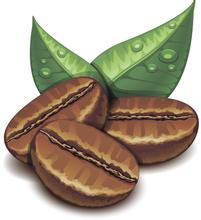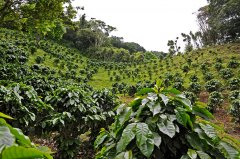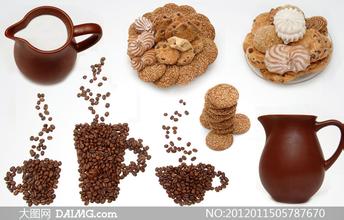Production method of coffee beans the production process of coffee beans
Coffee bean production process First coffee bean is a fruit picked from the coffee tree after fermentation of flat beans and round beans
The ripe red coffee fruit, shown here, has a multi-layered structure. The pale green kernel with a bluish center is the coffee bean.
The core of the coffee fruit is generally oval. When the two stones are paired together, they form a flat bean; sometimes the stone grows singly, forming a round bean. The difference between the two types of beans is mainly in taste.
From harvest to delivery
After harvest, the skin and flesh must be removed. Coffee beans are made by removing the endocarp and silver peel. There are two methods: drying (natural drying, non-washing) and washing.
Drying type, the operation is relatively simple, the harvested fruit spread on the dry site, in the sun for a week or two, turning when you can hear the sound of cluck cluck said dried. Then use a hulling machine to remove the flesh, endocarp and silver skin of the dried fruit.
This method gives coffee beans a mild acidity and a mild bitterness. Brazil, Ethiopia, Yemen and other places to use this method. Disadvantages: easily affected by weather, defective beans and foreign bodies mixed with the opportunity to many. Therefore, careful selection is required before shipment.
The method comprises the following steps of: pouring harvested fruits into a water tank, removing floating matters, moving the fruits in water into a pulp removing machine, stripping the skin and pulp, then putting the fruits back into the water tank, removing floating matters, pouring the "fruit core" in water into a fermentation tank, soaking for half a day or one day, removing colloid on the surface of fermented beans, washing, drying or mechanically drying, removing the endocarp on a hulling machine, and obtaining commercial green coffee beans.
The advantages of washing: coffee beans luster is good, mixed with less foreign matter, sour slightly better. This approach has been used in Colombia, Mexico and Guatemala. Coffee beans produced with water washing account for almost 70% of the total coffee bean production.
Sometimes bad fermentation time will produce fermentation odor and special sour taste; well processed, coffee beans can form a personalized aroma.
At this time, coffee beans can be packed into sacks and sent to various places, or packed into special containers and shipped across the ocean.

Important Notice :
前街咖啡 FrontStreet Coffee has moved to new addredd:
FrontStreet Coffee Address: 315,Donghua East Road,GuangZhou
Tel:020 38364473
- Prev

San Marco is the hottest coffee farm among the eight coffee producing areas in Guatemala.
The growth environment of boutique coffee beans also has higher requirements. Generally grow at an altitude of 1500 meters or even more than 2000 meters above sea level, with appropriate precipitation, sunshine, temperature and soil conditions. Some world-famous coffee beans also have a special geographical environment, such as the alpine clouds in the Blue Mountains, the free shade provided by the afternoon clouds in Kona, and the volcanic ash soil in Antigua.
- Next

What are the characteristics of coffee beans in the producing area of coffee beans
The origin of coffee the main producing area of coffee is in Africa. The story of the shepherd legends around the tenth century AD, on the Ethiopian plateau of Africa, there was a shepherd Karl. One day he suddenly looked very excited and excited when he saw the goat. He thought it was strange, and then after careful observation, he found that the sheep were excited after eating some kind of red fruit. Carl.
Related
- Does Rose Summer choose Blue, Green or Red? Detailed explanation of Rose Summer Coffee plots and Classification in Panamanian Jade Manor
- What is the difference between the origin, producing area, processing plant, cooperative and manor of coffee beans?
- How fine does the espresso powder fit? how to grind the espresso?
- Sca coffee roasting degree color card coffee roasting degree 8 roasting color values what do you mean?
- The practice of lattes: how to make lattes at home
- Introduction to Indonesian Fine Coffee beans-- Java Coffee producing area of Indonesian Arabica Coffee
- How much will the flavor of light and medium roasted rose summer be expressed? What baking level is rose summer suitable for?
- Introduction to the characteristics of washing, sun-drying or wet-planing coffee commonly used in Mantenin, Indonesia
- Price characteristics of Arabica Coffee Bean Starbucks introduction to Manning Coffee Bean Taste producing area Variety Manor
- What is the authentic Yega flavor? What are the flavor characteristics of the really excellent Yejasuffi coffee beans?

